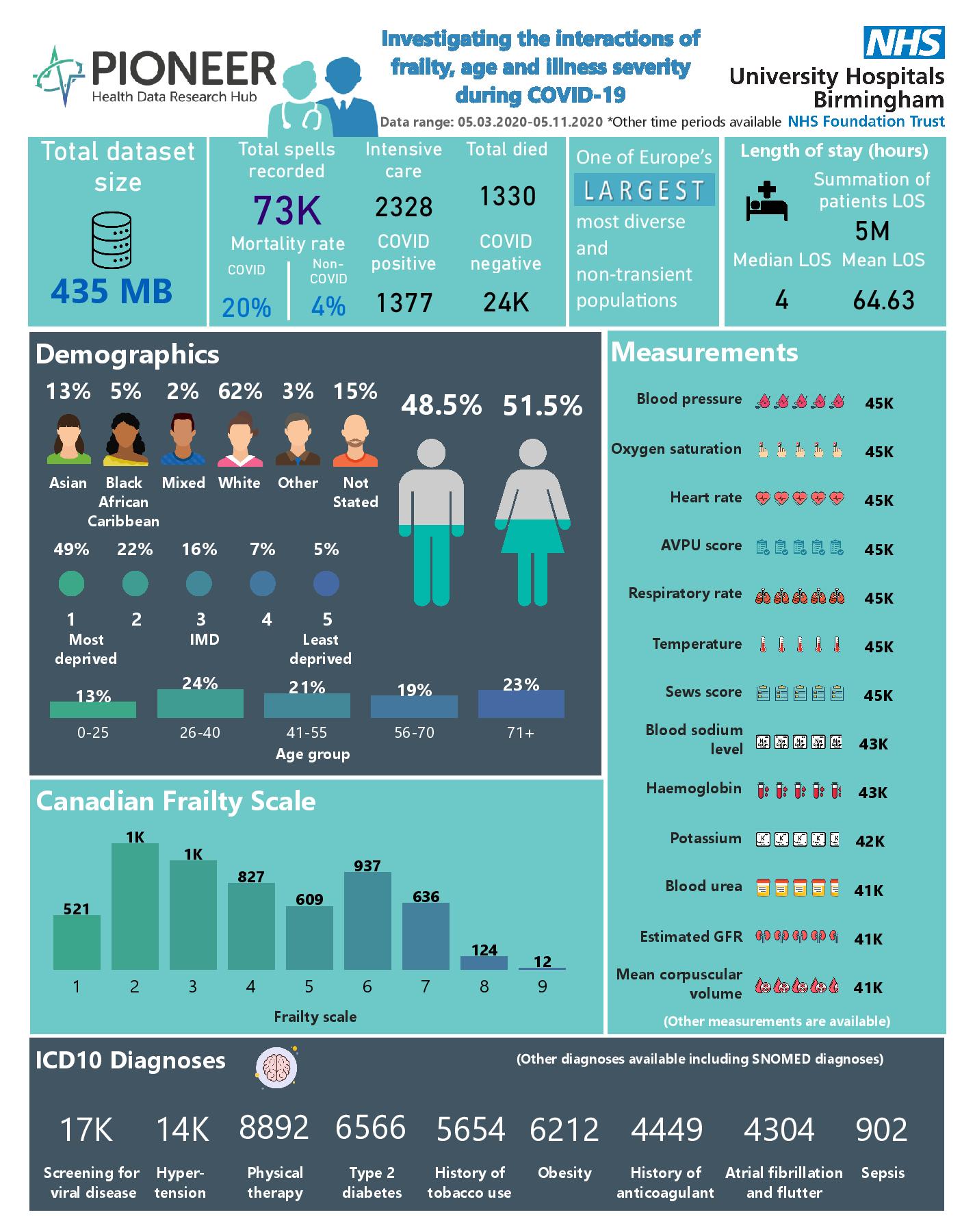Version: 1.0.0 | Published: 8 Oct 2024 | Updated: 425 days ago
Investigating the impact of frailty, age and illness severity during COVID-19
Dataset

Documentation
Associated Media:
Description:
Frailty is a syndrome of increased vulnerability to incomplete resolution of homeostasis (healing or return to baseline function) following a stressor event (such as an infection or fall) and it is associated with poor outcomes including increased mortality and reduced quality of life. Prevalence increases with age, but it should not be considered an inevitable consequence of ageing.
The pathophysiology of frailty is poorly understood but the immune and endocrine systems appear to be involved in its development or response. Age and frailty have been proven to be independently predictive of outcomes in patients admitted with an acute illness.
In COVID-19, routine frailty identification has been used to inform decision making about high level of treatment. This is because frailty usually moderates the effect of age on mortality. Anecdotally, this effect has not been recognised by clinicians looking after older COVID-19 patients. Four papers have been published so far on the effect of frailty on COVID-19 with differing results. However, all papers show the independent predictive value of age when controlling for frailty, which is not usually seen in studies of age and frailty in other acute illnesses.
PIONEER geography
The West Midlands (WM) has a population of 5.9 million & includes a diverse ethnic & socio-economic mix.
EHR: UHB is one of the largest NHS Trusts in England, providing direct acute services & specialist care across four hospital sites, with 2.2 million patient episodes per year, 2750 beds & an expanded 250 ITU bed capacity during COVID. UHB runs a fully electronic healthcare record (EHR) (PICS; Birmingham Systems), a shared primary & secondary care record (Your Care Connected) & a patient portal “My Health”.
Scope: All patients aged 18 years and above admitted for an acute illness in hospitals within University Hospitals Birmingham NHS trust during the COVID-19 pandemic. The dataset includes highly granular patient demographics & co-morbidities taken from ICD-10 & SNOMED-CT codes. Serial, structured data pertaining to acute care process (timings, staff grades, specialty review, wards), presenting complaint, acuity, all physiology readings (pulse, blood pressure, respiratory rate, oxygen saturations), all blood results, imaging reports, all prescribed & administered treatments (fluids, blood products, procedures), all outcomes.
Available supplementary data: Matched controls; ambulance, synthetic data.
Available supplementary support: Analytics, Model build, validation & refinement; A.I.; Data partner support for ETL (extract, transform & load) process, Clinical expertise, Patient & end-user access, Purchaser access, Regulatory requirements, Data-driven trials, “fast screen” services.
Coverage
Spatial:
United Kingdom,England,West Midlands
Typical Age Range:
18-110
Follow Up:
1 - 10 Years
Pathway:
Data is representative of the multi-ethnicity population within the West
Midlands (42% non white). Data includes all patients admitted during this
timeframe, with National data Opt Outs applied, and therefore is representative
of admissions to secondary care. Data focuses on in-patient stay in hospital
during the acute episode but can be supplemented on request to include previous
and subsequent hospital contacts (including outpatient appointments) and
ambulance, 111, 999 data.
Provenance
Origin
Purposes:
Care
Sources:
EPR
Collection Situations:
- Secondary care - Accident and Emergency
- Secondary care - In-patients
- Secondary care - Outpatients
Temporal
Accrual Periodicity:
Quarterly
Distribution Release Date:
25 May 2021
Start Date:
05 March 2020
End Date:
05 November 2020
Time Lag:
Other
Accessibility
Access
Access Service:
Trusted Research Environments (TRE) are built using Microsoft Azure services and
hosted in the UK to provide research teams a safe, secure and agile environment
which allows users to quickly analyse, interpret and form an enriched view of
primary care information through a range of integrated datasets. Health data
collated from multiple sources is ingested into a secure data lake which will
then allow subsets of data to be made available to research teams on approval of
a data request. Once approved a customer specific TRE is made available with a
standard set of leading analytical tools from Microsoft including Azure
Databricks, Azure Machine Learning, Azure SQL and Azure Synapse (for large-scale
data warehouses). Specific tools can be provided at an additional cost over the
standard platform data access charge and the PIONEER team will work with you to
determine your exact needs. Access to the TRE is managed using the latest
virtual desktop technology to provide a safe and secure end-user experience. By
utilising leading edge design PIONEER are able to create TREs rapidly to enable
us to service any customer requirement.
Access Request Cost:
www.pioneerdatahub.co.uk/data/data-services-costs/
Delivery Lead Time:
1-2 months
Jurisdictions:
GB-ENG
Data Controller:
University Hospitals Birmingham NHS Foundation Trust
Usage
Data Use Limitations:
General research use
Data Use Requirements:
Project-specific restrictions
Resource Creators:
This publication uses data from PIONEER, an ethically approved database and analytical environment (East Midlands Derby Research Ethics 20/EM/0158)
Format and Standards
Vocabulary Encoding Schemes:
SNOMED CT
Conforms To:
LOCAL
Languages:
en
Formats:
SQL
Observations
Statistical Population
Population Description
Population Size
Measured Property
Observation Date
Persons
73,204 Acute Hospital Admissions between 05-March-2020 and 05-Nov-2020.
73204
Count
25 May 2021
